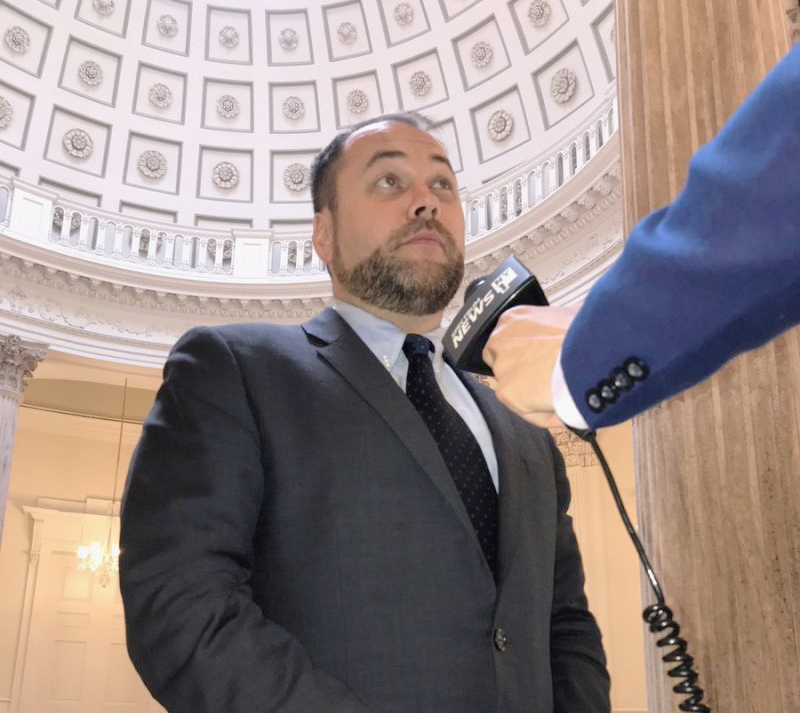Speaker Johnson: Make NYPD Bike Lane and Reckless Driver Enforcement Permanent … And Serious!

Make the blitz permanent!
The NYPD must seriously step up enforcement of reckless drivers as part of Mayor de Blasio’s “bicycle safety” plan that will be announced this week — an effort that must go beyond the police department’s current practice of periodic ticket blitzes, Council Speaker Corey Johnson said as he joined a chorus of advocates hoping to stop this year’s increase in road carnage.
“We’re not going to solve the crisis of cyclists losing their lives with a brief three-week crackdown — we need to keep enforcing rules keeping cars out of bike lanes,” Johnson told Streetsblog on Wednesday, highlighting an insufficient NYPD response to a spate of cyclist and pedestrian deaths this year that has undermined the city’s Vision Zero initiative.
Johnson also said the enforcement must come as part of “an interconnected network of protected bike lanes.”
More bike infrastructure will likely be part of any safety announcement, but Johnson and others have been putting the focus on the NYPD’s effort — or lack thereof — which was ordered up by the mayor on July 1, after three cyclists had been killed in just one week. At the time, the death toll was 15 cyclists. It has now risen to 17 — seven more than all of last year. Total fatalities on city roads are up 16 percent this year, too.
Over those three weeks, the NYPD response was either impressive or completely lame, depending on how you crunch the data. The agency did write nearly double the number of summonses to drivers who blocked in bike lanes during its July 1-21 enforcement effort — 8,648 summonses or 95 percent more than the same period last year.
Also, cops wrote 2,913 summonses to motorists who failed to yield to a pedestrian or bicyclist — a 17-percent increase over the same period last year, according to Sgt. Mary Frances O’Donnell, a police spokesperson.
But those numbers mean that cops — in the middle of a high-profile blitz — wrote just five blocked bike lane tickets per day per precinct and two failure-to-yield tickets per day per precinct. Those numbers are obviously a tiny fraction of the number of instances of both violations. Also, the so-called blitz did not include emphasis on other categories of violations that affect street safety, such as speeding, running red lights or distracted driving.
In addition, NYPD statistics published by Patch showed that before the blitz, the police effort on clearing blocked bike lanes was waning. Officers had issued 35,089 summonses to bike lane blockers between Jan. 1 and July 7, 2019 — a 14-percent drop.
That’s one reason why activists are calling for the NYPD to stay on its blitz footing.
“NYPD’s enforcement blitz must become permanent,” said Marco Conner, the interim co-deputy director of Transportation Alternatives. “We already know that enforcement has to be widespread and consistent to be effective. In addition NYPD must allow their Traffic Enforcement Agents to do the part of their job they’ve been trained for, namely to ticket drivers for moving violations like failing to yield and blocking the box. These are violations that occur on every New York City street throughout the day, and which Traffic Enforcement Agents are uniquely positioned to observe and enforce.”
But Conner took it further:
Our car culture is so that most of us fail to realize the awesome responsibility it is to drive a multi-ton vehicle where, similar to a loaded gun, a moment’s inattention or other error can cause someone to lose their life, especially in a dense city like New York. This car culture leads to drivers normalizing the dangerous practice of failing to yield to cyclists and pedestrians, speeding, and treating bike lanes as parking lanes — endangering everyone around them. Increased consistent enforcement is absolutely key to changing this culture, to the ultimate benefit of everyone.
The mayor’s announcement this week is clearly eagerly anticipated. It is expected to be multi-faceted, but the NYPD must be a key part of it, said Jon Orcutt of Bike New York.
“Cars and trucks don’t stay out of bike lanes because it’s a good idea,” said Orcutt, a former Department of Transportation official. “Enforcement needs to create a real disincentive for endangering bike riders, and that will only happen with a sustained, perpetual effort.”
City Hall declined to comment for this story. The NYPD did not respond to a request for comment.





